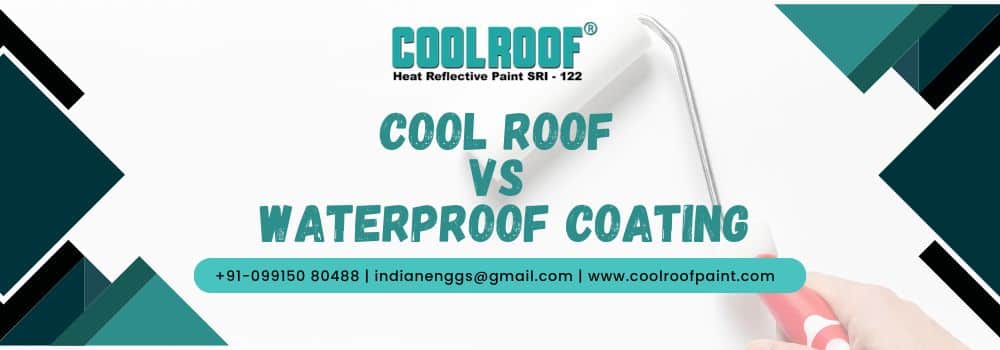It is one of the most important parts to take care of is the roof when you build your home or building. The roof protects us from sunlight, rain, and heat. But have you ever heard about Cool Roof and Waterproof Coating?
Many people get confused between the two, but both serve different purposes. Let’s understand in a simple way what they are, how they work, and which one is better for you.
What is a Cool Roof Coating?
A Cool Roof Coating is a peculiar kind of paint or layer that is used on the roof to reflect sunlight and thus, heat. It is excellent for cooling the building, particularly in hot summers.
It can be compared to putting on a white T-shirt on a bright sunny day. The white colour reflects the sun’s rays, so you are cooler than if you wore black. Like that, cool roof coatings turn back the majority of the sun’s rays from the roof.
How Cool Roof Coating Works?
Cool roof coatings are made up of reflective materials such as titanium dioxide or ceramic particles, which are the essential components of the coatings.
- These materials don’t let sunlight penetrate but instead reflect it.
- As a result, the roof heats up less and the interior of the building remains cool.
- Hence, the air conditioning requirement is reduced, and thus fewer electrical units are consumed.
Benefits of Cool Roof Coating
- Maintains the Temperature of the Building Cooler: Roof surface temperature is reduced by a great magnitude of up to 30–40%.
- Energy is saved: Demand for cooling is lessened due to the heat reduction.
- Eco-Friendly: Hits down the carbon footprint and urban heat.
- Prolongs Roof’s Life: Low temperature translates to less wear and tear, thus the roof will live longer.
- Economically Wise: Long-term savings on electricity bills are the major benefit.
Where to Use Cool Roof Coating
Cool roof coatings are ideal for:
- Homes in hot climates
- Factories, warehouses, and commercial buildings
- Schools, hospitals, and offices where energy saving is important
- Concrete or metal roofs that get too hot in the sun
Also Read: What is SRI in Cool Roof Paint?
What is Waterproof Coating?
A Waterproof Coating is used to prevent water from leaking or coming through the roof or walls. Its primary function is to guard against rain, water vapour, and humidity rather than cooling.
Just like wearing a raincoat. A raincoat is not a cooling device, but it does not allow rainwater to penetrate your clothes. In the same way, a waterproof coating does not allow water to enter the building and damage the building.
How Waterproof Coating Works
A layer that is thick, flexible, and continuous is made by the waterproof coatings on the roof.
- This layer serves as a water block.
- The coating closes the tiny fissures or holes in the roof completely.
- It prevents leaks, moisture, and mould from growing.
Benefits of Waterproof Coating
- Leakage Prevention: Rainwater cannot come in through the roof or walls anymore.
- Structural Protection: Prevents the appearance of cracks, rust, and moisture.
- Mould and Algae Control: Maintains the cleanliness and health of surfaces.
- Roof Life Extension: Creates a weather damage-resistant barrier.
- Maintenance Free: If necessary, it can be reapplied without any difficulty.
Where to Use Waterproof Coating
Waterproof coatings are ideal for:
- Areas with heavy rainfall
- Flat roofs, terraces, and bathrooms
- Underground walls or water tanks
- Buildings near coastal or humid areas
Key Differences: Cool Roof Coating vs Waterproof Coating
Let’s look at the main differences between these two coatings side by side:
| Feature | Cool Roof Coating | Waterproof Coating |
| Main Purpose | Reflects sunlight and keeps building cool | Prevents water leakage and moisture |
| Material Type | Reflective and heat-resistant | Water-resistant and flexible |
| Effect on Temperature | Reduces the roof and room temperature | Does not affect the temperature much |
| Best For | Hot and sunny regions | Rainy and humid regions |
| Color | Usually white or light-colored | Can be any colour (mostly grey or transparent) |
| Application Area | Roofs, terraces, and industrial buildings | Roofs, walls, basements, tanks |
| Energy Saving | Yes | No |
| Durability | 5–10 years (depending on quality) | 5–8 years (depending on weather) |
Can Both Coatings Be Used Together?
Yes! In many cases, combining cool roof and waterproof coatings gives the best results.
Here’s how:
- First, a waterproof coating is applied to seal cracks and prevent leakage.
- Then, a cool roof coating is applied on top to reflect sunlight and reduce heat.
This two-layer protection makes the roof both heat-resistant and leak-proof, perfect for areas with both hot summers and heavy rains.
Also Read: Benefits of High SRI Cool Roof Paint
Which One Should You Choose?
The decision regarding which one to use, Cool Roof Coating or Waterproof Coating, is based on your location and the issues you want to address.
Go for Cool Roof Coating if:
- You are residing in a hot and sunny region.
- Your roof gets excessively hot during the daytime.
- You are eager to lower your electricity bill.
- Your primary goal is to control temperature.
Opt for Waterproof Coating if:
- You are living in a moist or coastal area.
- You have leakage or dampness issues with your roof or walls.
- You want to secure your construction against water damage.
- Your primary goal is to stop water permeation.
Final Thoughts
The cooperation of both Cool Roof Coating and Waterproof Coating gives the home or building very effective protection.
- A Cool Roof Coating not only keeps the building cool but also keeps the energy bill low.
- A Waterproof Coating acts as a barrier against moisture and prevents your house from suffering any damage.
In fact, if your location is characterised by hot weather and heavy rain, using both coatings at the same time could be a solution for maximum comfort and protection.
Selecting the right coating will not only create a comfortable atmosphere in your home but also help in making your house more efficient in energy consumption, as well as being durable. Moreover, a reduction in the costs of maintenance and electricity will be the added benefit.









